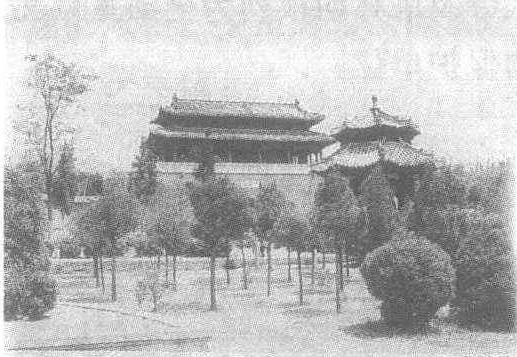中岳庙
位于河南省登封县嵩山黄盖峰下。这是一座规模宏大的寺庙建筑,始建于秦,名太室祠,北魏时改称中岳庙,庙址屡次变迁,唐中叶迁至此。现存建筑多为清代重建,占地10万平方米左右。现有楼阁、殿宇等400余间,以一条南北轴线贯穿,从中华门起排列着遥望亭、天中阁、崇圣门、化三门、峻极门、中岳大殿寝殿、御书楼,长达1300米。其中主要建筑是中岳大殿,面阔九间,进深五间,重檐庑殿顶。台基高2米,四周围汉白玉石栏杆。殿前有月台,木棂花门窗和斗拱都雕刻得十分精致。整个大殿气势宏伟,殿内正中天花的藻井雕有盘龙,其工艺十分精湛。

中岳庙
中岳庙从历史上讲最早应该建于秦代,后来几经变迁,至唐终于固定位置,没有再迁移,经过历朝历代千百年的修建、扩展,至清乾隆年间而大变,确定以北京故宫格局建之,所以有“小故宫”之称。和故宫一样,中岳庙有一条中轴线,沿中轴线从中华门始,依此排列有遥参亭、天中阁、配天作镇、崇圣门、化山门、峻极门、嵩高峻极坊、中岳大殿、寝殿、御书楼。在中轴线的两侧则有太尉宫、火神宫、祖师宫、九龙宫、神州宫。中岳庙的另一特色就是它有大量的古柏,最早的可追溯到汉代。
中岳庙
道教宫观。在河南登封太室山南麓。是我国现存最早,在中原地区规模最大的道教庙宇。创建于秦,称太室祠。汉武帝“礼登中岳太室。以三百户封太室奉祠,曰崇高邑” ( 《史记·封禅书》)。东汉安帝在祠前建太室石阙和石翁仲,雕刻古拙,气势轩昂。北魏时曾三迁庙址,最后迁到黄盖山上。唐“则天号嵩山为神岳,尊嵩山神为天中王,夫人为灵妃” ( 《旧唐书·礼仪志》)。后来又封为天中帝,成为五岳中第一个被封王、封帝者。唐中宗时去其帝号,玄宗时改为中天王并将庙址改建于黄盖峰下,即今址。北宋增修后,已是 “飞甍映日,杰阁联云” ( 《中岳庙志》) 的景象,清代又扩建,现存庙宇基本上保留了清代的规模。庙背依黄盖峰,面对玉案山,四周群山环抱,风景秀美。从中华门起,经遥参亭、天中阁、配天作镇坊、崇圣门、化三门、峻极门、崧高峻极坊、中岳大殿、寝殿到御书楼共十一进,长达1. 3公里,面积10多万平方米,现存各种建筑400余间。特别是中岳大殿建在高大的石栏月台上,面阔九间、进深五间,重檐庑殿顶,黄瓦红墙,气势雄伟,梁枋天花皆绘清代尊贵的和玺彩画。殿内供奉中岳大帝塑像,据传 “岳神姓悍, 讳,主世界土地山川……” ( 《民间诸神》)。在古 “神库” 四角有北宋治平元年(1064)铸造的四大铁人,高约3米,虎背熊腰,挺胸眦目,振臂握拳虎虎有生气。此地原为燎祭时的“火池”,四铁人为 “持钮维以系络” 所用 ( 《说嵩》)。四铁人是北宋铸造艺术的杰作,也是现存镇库铁人中体形最大,保存最好的。寺内 《中岳嵩高灵庙之碑》系魏碑中的精品。
中岳庙
位于城东4公里黄盖峰下。始建于秦,西汉元封元年(前110)汉武帝游嵩山时,令祠官加以扩建,约在北魏时改今名。庙址屡有迁徙,唐代中叶始定于现址。唐、宋年间盛极一时,有“飞甍映日,杰阁联云”之称。现存为清代重修,是河南省规模最大的寺庙建筑。从中华门起,经遥参亭、天中阁、配天作镇坊、崇圣门、化三门、峻极门、崧高峻极坊、中岳大殿、寝殿到御书楼共十一进,长达1.3公里,面积10余万平方米。有楼、阁、宫、殿、台、廊、碑楼等建筑400余间。中岳大殿共有45间,红墙黄瓦,气势雄伟。庙内有唐宋以来古柏300余株,金属铸器和石刻碑碣100余座,尤以北魏的中岳嵩山高灵庙之碑最为驰名,为古代书法艺术珍品。庙前石翁仲,刀法古拙。北宋铸造的四大铁人,为我国现存镇库铁人中形体最大、保存最好的佳作。
中岳庙
中国古庙。位于河南省登封县城东嵩山太宝山南麓黄盖峰下。始建于秦,前身为太室祠,是1座道教庙宇,占地约10 hm2,几经变迁,现在的庙址迄于唐玄宗初年(713),宋代2次增修,殿宇、行廊900多间,至清朝几次大规模修、扩建。现存的建筑群以南北轴线贯穿,最南端为中华门及遥参亭,然后建有天中阁、崇圣门、化三门、峻极门、中岳大殿、寝殿、御书楼,北边是黄盖亭。主要建筑是中岳大殿,面阔9间,进深5间,坐落在高2 m多的台基上。
中岳庙
见“嵩山”。